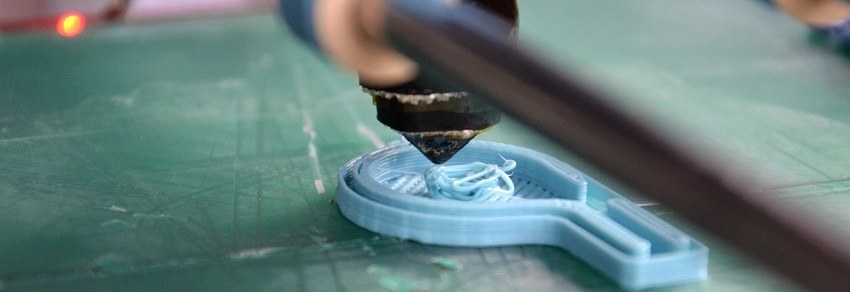

Copiers and printers: 3D printers: for what types of business?
Reality is closing in on fiction. With 3D printers, many science-fiction themes such as the dream of replicating any objects illustrated in many popular movies such as Star Trek now suddenly seem within grasp. On the commercial side, it’s simply a totally new market, which appeared in just a few years.
But now that 3D printers have become widely available, with many manufacturers and models competing, choosing a 3D printer has become as difficult as choosing a good old 2D printer. And although many company executives are fascinated by 3D printing technology as a symbol of innovation... they don’t really know what purpose these machines could serve in their business.
How can we compare 3D printers in 2019?
Answering this question and giving the keys to identifying the best 3D printer for one’s needs requires a bit of understanding of what these machines exactly are, how they work, the current state of the market, its main players and the costs of 3D printers.
Understanding 3D printers
The difficulty in understanding how these state-of-the art printers work is explained by the fact that there are almost as many types of printers and printing technologies as there are specific applications and functions for 3D printers, depending on the industry where they are used.
3D printers: a definition
3D printing is also called “additive” manufacturing and refers to several different processes used to make three-dimensional items to physically represent a three-dimensional digital file.
As opposed to “subtractive” manufacturing, 3D printing does not involve removing material from a source or hollowing it out to give it a shape. It’s actually about building a shape by adding layers and layers of material, like as many cross-sections of the final item.
Very much in the same way as “two dimensional” printing on paper, 3D printers are therefore piloted by computers where the original image is stored or made. And actually, inkjet printing is already about adding several layers of ink onto each other so it becomes visible. These layers are just too thin to be seen by an untrained human eye.
How 3D printing processes work
It is important to understand that all 3D printer models do not necessarily use the same technology at all. However, there are common processes which are almost always used.
These printers use several technical methods to print, differing mostly in the way the layers of the printed object are created and piled up. Stereolithography, fused deposition modelling (FDM) and selective laser sintering (SLS) are the three most common methods used. The American Society for Testing and Materials has conveniently classified a list of seven processes normally used in 3D printing:
- Vat Photopolymerisation, either by stereolithography, digital light processing or continuous liquid interface production,
- Material Jetting,
- Binder Jetting,
- Material Extrusion, by fused deposition modelling or fused filament lamination,
- Powder Bed Fusion, by selected laser sintering or direct metal laser sintering,
- Sheet Lamination,
- Directed Energy Deposition.
Practically, no matter which of these techniques is used, 3D printing relies on the following method:
- Creating the 3D image of the item: this can be done either from the ground up with 3D modelling software, or by scanning of the model item to create a digital copy and reproduce it with the printer.
- Making the image ready for print production: this is called “slicing”. Indeed, the 3D image is sliced into hundreds, thousands of super thin layers. Slicing software is required.
- Actually printing the image: just as the 3D image was sliced into thousands of layers, the printer will recreate the shape by “printing” layer after layer after layer... Just how these layers are “printed” depends on the aforementioned technology used. Some are related to the projection of plastic polymers or metals, some are more comparable to welding, others by digging and melting powder to give it the desired shape.

Main business purposes and relevant industries
The technology is impressive but... what can we actually “print” with these machines that makes sense for a business? There are two main uses for 3D printing: making models or prototypes and making actual production items. These two purposes respectively appeal to product design and engineering and are especially relevant in the medical, aerospace, aviation and automotive industries, with architecture and fashion catching up fast.
Medical industry
The medical industry has been using 3D printing since the technology was created, as early as the 1980s. Today, full implants are now commonly made using 3D printing. The production of dental implants and prosthetics more specifically is being completely revolutionised by 3D printing, bringing the whole fabrication process back into the dentist’s hands. 3D printing makes it easy to manufacture prosthetics which were really difficult or even impossible to make before.
While it is not possible to replicate human tissue yet, bio-printing is already a reality concerning small layers of living cells.
Aerospace and aviation industries
3D printing is now commonly used to create prototypes and sometimes even production parts for various aircrafts or vessels. For example, Nasa makes combustion chamber lines using 3D printing technologies, and GE aviation has come up with the first 3D printed jet engine part.
Automotive industry
Quite similarly, the automotive industry is also using these printers now quite commonly. Typical uses include concept models, design verification and the marking of fully functional vehicle and engine parts. It is estimated that 3D printing in this industry only will represent a £1.1 billion market by the end of 2019.
Architecture
The potential of 3D printing is also especially valuable in the building industry.
With 3D printing, architects can easily produce models of buildings for their customers to see, and even simulate and test the stress and strain conditions of an actual building in these models. Experiments have also been made in China to simply 3D print real-size entire houses, nothing less!
Fashion
Fashion is also an area where 3D printing is relevant because of the need to produce several “prototypes” of dresses and actually trying them on before deciding on the best design. Some fashion designers are already using 3D printing for that purpose, and simply print dresses or other garments. Experiments in production applications have been made and some have even led to commercial manufacturing, with Adidas 3D-printing soles of one of their sneakers.
Finding the right 3D printer, at the right price
The market for these printers is a booming, not-yet consolidated one, with many new players arriving and pushing prices always a bit lower than the competition.
Choosing a 3D printer
Choosing a 3D printer logically involves taking very different factors into account than those usually observed for choosing a regular printer. However, some of these factors can be compared. Main discriminating factors include:
- Technology used. This is about all the 3D-printing processes listed earlier. One difficulty of 3D printing is that users really need to know beforehand what kind of item they want to print, and how they’re going to print it, as different projects require different printing processes.
- Filament type. For simple projects, this choice can be narrowed down to the type of filament used for printing, which represents the basic source material of the finished printed item. Filaments are like wires of material melted to be put into shape and form the layers of the finished object. Popular filament types include polylactic acid (or PLA, the most common type), acrylonitrile butadiene styrene (or ABS, which is more resistant) and polycarbonate (or PC, even more resistant).
- Print resolution. Yes, like your home printer, 3D printers also have their resolution. But it’s not defined in points per pixel, but rather in microns. And it’s not the higher value the better, but the opposite. Microns (or micrometres) is the millionth of a metre and refers here to the thinnest thickness of the layer, therefore the level of detail achievable.
- Print speed. Like 2D printing, 3D printing comes at varying speeds. And unlike printed papers, printing one 3D item can literally take hours. Print speed is mentioned in mm./s or millimetres per second. Printing speeds never stop increasing, and 50 mm./s is now considered a minimum, as some models can print as fast as 1,000 mm./s. Some 3D printing technologies are definitely faster than others.
- Bundled software. It’s understandable that nothing can be printed without the correct software. Even if advanced technicians always prefer to choose their software independently from the hardware, recommendable 3D-printer manufacturers ship dedicated software with their machines, even industry-specific software for the best providers. In some cases, the printer can only be used with software produced by the manufacturer of the printer.
Prices of 3D printers
The price range of these printers is extremely wide: if the cheapest models are now affordable to nearly anybody, latest technologies can cost dozens of thousands of pounds.
The printing process technology used makes a big difference:
- Material jetting printers usually sell at over £15,000,
- Printers using plastic powder (Multijet or SLS) at over £5,000,
- Prices of printers using resin (DLP, DLS, SLA technologies...) start at under £200,
- Material extrusion printers sell for less than £120, and up to £180,000!
Major manufacturers
Users with little knowledge of 3D printing could think that manufacturers of traditional printers would have naturally made themselves known in the 3D printing industry. But as technologies are completely different, this is not the case at all. Respected manufacturers of 3D printers include:
- Makerbot;
- Hyrel 3D;
- Ultimaker;
- Zortrax;
- Cellink;
- Printrbot;
- Robo3D;
- Formlabs...
More information on Copiers and Printers - What additional functions do I get with an all-in-one office printer? - How do I connect a photocopier to my computer network? - What are the latest advances in printer-photocopier technology? |
Discover the buying guide for Copiers and printers
-
Defining office photocopiers in 2025 – and choosing the right model

-
Getting the best from your multifunction printer

-
Top 5 portable photocopiers and printers in the UK in 2025

-
Finding the best small office printers in 2025

-
Choosing a fax machine in 2025

-
How do wireless printers and fax machines work?

-
What to look for in a thermal printer

-
Wireless printing is now

-
Small printers for big productivity

-
Wireless printers coming of age

-
Doing it all with multifunction printer-copiers

-
3D printers in action


